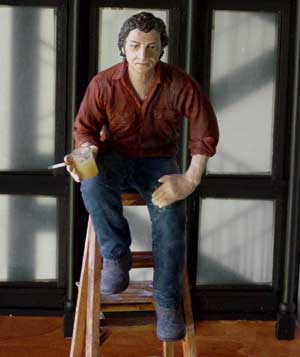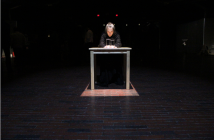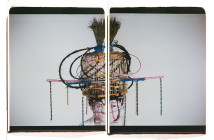By means of the 3rd dimension used in minature, Joe Fig has happily provoked the nuances of what it is to be an art lover. Whether his objects can be labeled as sculpture, diorama, or physically embodied art history, Fig has tagged many of the critically defining elements surrounding this great condition called Art. This is the very condition that has brought, you, gentle reader, to this review. Joe Fig reminds us how involved we all are in the object, process, history, and celebrity that comprise the World of Art.
In his series called Pop, currently on exhibit at the Bernard Toale Gallery until the 26th of June, famed artists make art in the setting of their studios, all rendered in a doll sized scale. Roy Lichtenstein stares blankly while sitting against a dotted wall where some of his cartoon-like images hang, Andy Warhol down on all fours makes a large silkscreen of a flower pattern, Alex Katz paints his volumnous faces and landscapes inside a volumnous room. As Fig works from photographs or first-hand observation to create these studios, an interesting recontextualization of time and compression of media takes place between what Fig has been able to examine in person or glean from photographs to translate into the physical.
Immaculately created out of various substances including wood, clay, paper, plastic and acrylic, the first provocation of the work is the awe of the art object. The clay artists are not necessarily lifelike, they do not have to be, but the environment itself is a testament to the wonders of construction. Fig has taken the care to reproduce delicious little items such as a mini roll of packing tape in Warhols‚ studio, mini Lichtenstein paintings, even mini labels on fingernail sized cans of paint among mini art tools in various studios. The studios, some complete with ubiquituous streaks of paint and various forms of detritus strewn about, look exactly as what one imagines they would look like, but reduced.
This landscape of the artist in his studio is endlessly active one. History is a clear implication here, the demonstrated artists are each working in not only a specific time in their own art careers, but in art history as well. In this case, it is during the time of Pop Art. Jim Rosenquist shown to be laboring not only in a specific place, his studio, but in a specific time as well, 1980. Each piece in this show is a capsule, a monument in minature, to an art moment. One cannot help but feel a nostalgia for this art historical scene and the quaint efforts of the heroic artist individual. A grim faced figure lost in thought at his desk is none other than Jasper Johns, as recognized by a unique white number 5 on that desk. But while instances like these are expressed, what is truly revealed by Fig is not simply the process of artmaking, but most interestingly, the imagination of that process.
This imagination is a twofold practice, one is simply a revealing of what the hand of the artist is doing. As reflected in Pop Art, Lichtenstein exaggerates the Ben-Day dots that comprise his images; Warhol prints his silkscreens in multiple variations, revealing the changing syntax behind the process of silkscreening. Fig‚s pieces also reveal the hand of the artist as it relates to producing the surface of the object, but he also does one better. As the art movements in the latter half of the 20th century begat an interest in the artist themselves beyond their art creations, Fig indulges our need to see. To see a Warhol print is not just to reflect on the art itself, but also on the celebrity of Andy Warhol as a cultural icon. Now in the early years of the 21st century, our need to see is heightened to the extent that we want to see our celebrities in aspects of their lives beyond their polished public personas. In that case, the omniscent gaze of the viewer upon Fig‚s action figure Warhol struggling within the forces of artmaking is little different than seeing the cartoonish Ozzy Osbourne struggling with domesticity on MTV.
Now as the artists themselves have become figurines, and acts of art creation have become objects, and art history become physical, does this change the role of the art patron, the art collector? Perhaps a lover of Lichtenstein will henceforth be less satsified with a painting, poster, biography, or monograph than an object describing the act of Lichtenstein making a Lichtenstein.
"The Action Figure Artist: Joe Fig" is on view now at insert Bernard Toale Gallery.
All images are courtesy of the artist and Bernard Toale Gallery.
Ben Sloat is a regular contributor to Big, Red & Shiny.




